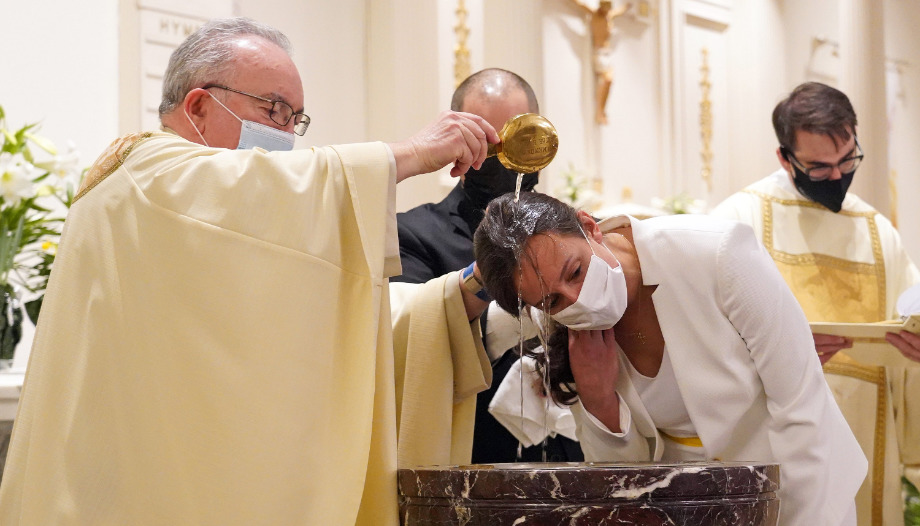




















According to the Catechism of the Catholic Church -The sacraments "are efficacious signs of grace, instituted by Christ and entrusted to the Church, by which divine life is dispensed to us. The visible rites under which the sacraments are celebrated signify and realize the graces proper to each sacrament".
In addition, point 1084 states that "the following are sensitive signs -words and actions- accessible to our present humanity".
What are they, what do they mean and how are the sacraments celebrated?
As is well known, the seven sacraments correspond to all the important moments of the Christian's life: they give birth and growth, healing and mission to the Christian's life of faith. We could say that they form an orderly whole, in which the Eucharist is at the centerIt contains the very Author of the sacraments, Jesus Christ.
Each sacrament is made up of tangible elements that constitute the matter: water, oil, bread, wine, on the one hand; and human gestures -ablution, anointing, imposition of hands, etc.- on the other. In addition, the words pronounced by the minister are part of the sacrament, constituting the form.
In the liturgy or celebration of the sacraments there is an unchangeable part -established by Jesus Christ himself- and parts that the Church can modify, for the good of the faithful and greater veneration of the sacraments, adapting them to the circumstances of place and time.
In this and the following articles, we propose to briefly define this matter and the current form of each of the sacraments.
What are the material element, human gestures and words in Baptism?
The matter of Baptism is natural water, as declared by the Council of Trent as a dogma of Faith, since this is what Christ ordained and the apostles accepted.
The celebration of Baptism begins with the so-called "rites of reception", which attempt to discern the willingness of the candidates - or of their parents in the case of minors or those under guardianship - to receive the sacrament and to assume its consequences. The biblical readings follow, which illustrate the baptismal mystery and are commented on in the homily.
Then the intercession of the saints is invoked, in whose communion the candidate will be integrated; with the prayer of exorcism and the anointing with the oil of catechumens, divine protection against the insidiousness of the devil is signified.
The water is then blessed with the Trinitarian profession and the renunciation of Satan and sin.
Thus comes the sacramental phase of the rite, through ablution, in such a way that the water runs over the head of the catechumen, signifying the true washing of the soul.
As the minister pours the water three times over the candidate's head - or immerses it - he pronounces the words: "NN, I baptize you in the name of the Father, and of the Son, and of the Holy Spirit". The sacrament is conferred only once and with indelible, indelible character.
After the administration of the sacrament we encounter the post-baptismal rites: the head of the baptized is anointed - if the administration of the sacrament of Confirmation does not immediately follow - to signify his participation in the common priesthood and to evoke the future chrismation in that other sacrament. A white vestment is given as an exhortation to preserve baptismal innocence and as a symbol of the new pure life conferred.
The candle lit in the paschal candle symbolizes the light of Christ, given to live as children of light. The rite of the "effeta", performed on the ears and mouth of the candidate, can be added to signify the attitude of listening to and proclaiming the word of God.
What are the material element, human gestures and words in Confirmation?
The matter of the sacrament of Confirmation is the "chrism", composed of olive oil and balsam, consecrated by the bishop - or patriarch in the case of the Eastern rite - during the Chrism Mass preceding the moment of celebration of the sacrament.
Before receiving the anointing, the candidates are called to renew their baptismal promises and make profession of faith.
Then the bishop - or the minister to whom he has expressly delegated the celebration of the sacrament - extends his hands over the confirmands and invokes the outpouring of the Holy Spirit - or Paraclete - upon them.
This gesture is accompanied by the anointing of the chrism on the candidate's forehead, which indicates how the third person of the Blessed Trinity penetrates to the depths of the soul.
Thus, the sacrament is conferred by anointing the forehead with holy chrism and pronouncing these words: "Receive by this sign the gift of the Holy Spirit". It is a visible sign of the invisible gift: here too the sacrament is conferred on us only once and indelibly, configuring us more fully to Jesus and giving us the grace to spread the good odor of Christ throughout the world. The rite concludes with the greeting of peace, as a manifestation of ecclesial communion with the Bishop.
The confirmed person thus completes the supernatural gifts characteristic of Christian maturity. In this way he receives with particular abundance the gifts of the Holy Spirit and is more closely linked to the Church, and is more committed to spreading and defending the faith by word and deed.












